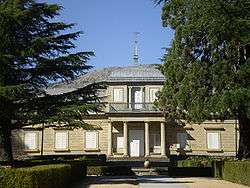Casita del Príncipe (El Escorial)
| UNESCO World Heritage site | |
|---|---|
| Location | Community of Madrid, Spain |
| Part of | Monastery and Site of the Escurial, Madrid |
| Criteria | Cultural: |
| Reference | 318 |
| Inscription | 1984 (8th Session) |
| House of the Prince | |
|---|---|
|
Native name Spanish: Casita del Príncipe | |
 The Casita is set in a garden with conifers much taller than the building | |
| Location | San Lorenzo de El Escorial, Spain |
| Coordinates | 40°35′04″N 4°08′11″W / 40.584379°N 4.136514°WCoordinates: 40°35′04″N 4°08′11″W / 40.584379°N 4.136514°W |
| Architect | Juan de Villanueva |
| Architectural style(s) | Neoclassical |
| Official name: Casita del Príncipe | |
| Type | Non-movable |
| Criteria | Monument |
| Designated | 1992 |
| Reference no. | RI-51-0007308 |
 Location of House of the Prince in Spain | |
The House of the Prince (Spanish: Casita del Príncipe) is an eighteenth-century building located in El Escorial, Spain. It was designed by the neoclassical architect Juan de Villanueva for the private use of the heir to the Spanish throne Charles, Prince of Asturias and his wife Maria Luisa . It was constructed in the 1770s and extended in the 1780s.
The word casita is the diminutive of the Spanish word for "house". The building was designed without bedrooms, as its owners slept in the palace which had been built two centuries earlier for Philip II. Such buildings gave their royal occupants the opportunity to escape some of the formalities of court life. The Petit Trianon at Versailles offers a French example of the phenomenon.
Setting
The building is set in a formal garden. The garden is in turn set in a walled park.
The garden, which is on several levels, is delineated by box hedges in 18th century style. It also features some exotic conifers, such as Sequoiadendron giganteum, a species introduced to Europe in the 19th century, and Abies nordmanniana (see note1).
Interior
The interior is decorated in neoclassical style with some Pompeian influence.
There is a Sala de Porcelana on the upper floor. This room features jasperware plaques in neoclassical style. Reminiscent of the work of the English Wedgwood company, the plaques were made in Madrid in the 1790s by the Real Fábrica del Buen Retiro.[1]
Conservation and access
The building is protected as part of a World Heritage Site. Under Spanish law it was declared Bien de Interés Cultural in 1992. Guided tours are offered by the Spanish heritage organisation Patrimonio Nacional.
See also
Related buildings
- Casita del Príncipe (El Pardo): Villanueva designed another building called Casita del Príncipe, for the same royal client. This later building is also in the proximity of a royal palace, that of El Pardo.[2]
- Casita del Infante: Villaneuva designed another house in El Escorial, the Casita del Infante, for the Prince's younger brother Gabriel. The two "casitas" form a pair, with the Casita del Infante having the alternative name of the Casita de Arriba (the upper casita) indicating its position relative to the Casita del Príncipe.
References
- ↑ "Sala de Porcelana de la Casita del Príncipe". Centro Virtual Cervantes. Retrieved 2 October 2016.
- ↑ "La Casita del Príncipe tiene llave nueva" (in Spanish). El País. 2009. Retrieved January 17, 2013.
Notes
- 1.^ The conifers are associated with the national forestry school which was moved to El Escorial in the late 19th century (Real Orden de Regencia. 25.10.1869).
External links
| Wikimedia Commons has media related to Casita del Príncipe. |
- Secuoya gigante en el jardín de Casita del Principe en Parque del Monasterio(information regarding remarkable trees)
